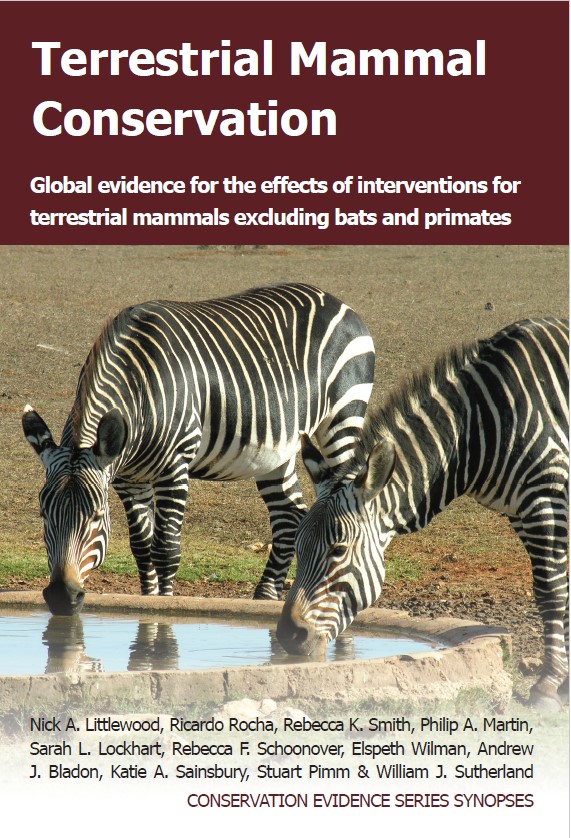Actions to conserve biodiversity
We have summarised evidence from the scientific literature about the effects of actions to conserve wildlife and ecosystems.
Review the evidence from the studies
Not sure what Actions are? Read a brief description.
Search for evidence
e.g. "frogs chytrid"
294 Actions found
Refine
Hide
294 Actions found
Download Actions
| 0 selected |
|
Order results by:
| Action | Effectiveness | Studies | Category | |
|---|---|---|---|---|
|
Remove roadkill regularly to reduce kill rate of predators/scavengers Action Link |
No evidence found (no assessment) | 0 |
|
|
|
Remove topsoil that has had fertilizer added to mimic low nutrient soil Action Link |
No evidence found (no assessment) | 0 |
|
|
|
Remove trees and shrubs to recreate open areas of land Action Link |
Likely to be beneficial | 2 |
|
|
|
Remove understorey vegetation in forest Action Link |
Unlikely to be beneficial | 3 |
|
|
|
Remove vegetation by hand/machine Action Link |
Likely to be beneficial | 20 |
|
|
|
Remove vegetation using herbicides Action Link |
Unlikely to be beneficial | 6 |
|
|
|
Remove/control non-native amphibians (e.g. cane toads) Action Link |
No evidence found (no assessment) | 0 |
|
|
|
Remove/control non-native invertebrates Action Link |
Unknown effectiveness (limited evidence) | 1 |
|
|
|
Remove/control non-native mammals Action Link |
Beneficial | 25 |
|
|
|
Remove/control non-native mammals within a fenced area Action Link |
Likely to be beneficial | 1 |
|
|
|
Remove/control non-native plants Action Link |
Unknown effectiveness (limited evidence) | 2 |
|
|
|
Remove/control non-native species that could interbreed with native species Action Link |
No evidence found (no assessment) | 0 |
|
|
|
Replant vegetation Action Link |
No evidence found (no assessment) | 0 |
|
|
|
Restore former mining sites Action Link |
Likely to be beneficial | 12 |
|
|
|
Restore or create forest Action Link |
Likely to be beneficial | 5 |
|
|
|
Restore or create grassland Action Link |
Likely to be beneficial | 3 |
|
|
|
Restore or create savannas Action Link |
Likely to be beneficial | 2 |
|
|
|
Restore or create shrubland Action Link |
Likely to be beneficial | 3 |
|
|
|
Restore or create wetlands Action Link |
Unknown effectiveness (limited evidence) | 4 |
|
|
|
Restrict use of rodent poisons on farmland with high secondary poisoning risk Action Link |
No evidence found (no assessment) | 0 |
|
|
|
Retain buffer zones around core habitat Action Link |
No evidence found (no assessment) | 0 |
|
|
|
Retain dead trees after uprooting Action Link |
Unknown effectiveness (limited evidence) | 1 |
|
|
|
Retain riparian buffer strips during timber harvest Action Link |
No evidence found (no assessment) | 0 |
|
|
|
Retain understorey vegetation within plantations Action Link |
Unknown effectiveness (limited evidence) | 1 |
|
|
|
Retain undisturbed patches during thinning operations Action Link |
Unknown effectiveness (limited evidence) | 2 |
|
Download Actions
| 0 selected |
|

Terrestrial Mammal Conservation - Published 2020
Terrestrial Mammal Conservation
Watch this search
If you are familiar with RSS feeds, please click the button below to retrieve the feed URL:
RSS feed for this searchIf you are unfamiliar with RSS feeds, we would suggest reading this BBC article.
Unfortunately, due to the number of feeds we have available, we cannot provide e-mail updates. However, you could use tools such as Feed My Inbox to do this for you.
What are 'Individual studies' and 'Actions'?
Individual studies
An individual study is a summary of a specific scientific study, usually taken from a scientific journal, but also from other resources such as reports. It tells you the background context, the action(s) taken and their consequences.
If you want more detail please look at the original reference.
Actions
Each action page focuses on a particular action you could take to benefit wildlife or ecosystems.
It contains brief (150-200 word) descriptions of relevant studies (context, action(s) taken and their consequences) and one or more key messages.
Key messages show the extent and main conclusions of the available evidence. Using links within key messages, you can look at the paragraphs describing each study to get more detail. Each paragraph allows you to assess the quality of the evidence and how relevant it is to your situation.
Where we found no evidence, we have been unable to assess whether or not an intervention is effective or has any harmful impacts.





)_2023.JPG)














